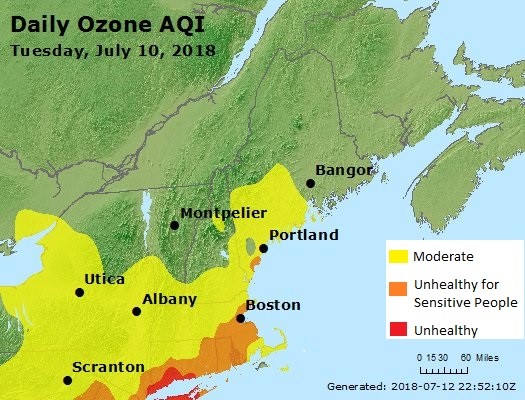Air

Good Air Days
The Number of Days When There Was No Exceedance of a Federal Air Standard in Connecticut
Connecticut residents breathed unhealthful air on 23 days in 2018: three more days than in 2017, but an improvement over the 10-year average.
A Good Air Day is when every
monitoring station in the state records satisfactory air quality. “Satisfactory air quality” is defined here as air that meets the health-based ambient air quality
standards for all of the following
six pollutants: sulfur dioxide, lead, carbon monoxide, fine particles, nitrogen dioxide and ground-level ozone.
Connecticut’s goal is to have air that meets health-based standards for all six pollutants. Violations of health-based air quality standards have been eliminated for five of the six pollutants, leaving ground-level ozone as the only remaining chronic problem. (As described on the CEQ Air Pollution Index
page, the levels of lead are so low that the possibility of violations is remote; the standards remain in place, however.)
Ground-level ozone is created when nitrogen oxides and organic compounds in the air react in the presence of sunlight. Weather is a major factor in year-to-year fluctuations. Motor vehicles remain a large source of ozone-forming emissions despite improvements in tailpipe standards.
The map below illustrates a bad-air day in 2018 that was more intense than average but followed the typical pattern of Connecticut having the worst ozone pollution in New England.
Source: U.S. Environmental Protection Agency Region 1
The yellow areas met the air quality standard for ground-level ozone, while the orange and red areas did not. Some residents in yellow areas who are unusually sensitive to pollution might have been affected. Much of Connecticut's ground-level ozone originates in states to the west. Unless emissions in those states are reduced substantially, Connecticut residents could continue to breathe unhealthful air.
Cities and towns in coastal regions of the state usually see more bad ozone days than inland locations. Coastal towns with monitoring stations that saw the most unhealthful days in 2018, included Stratford and Greenwich (14 each), Madison (13), Westport (12), and Middletown (8), while East Hartford (1) saw the fewest. No other New England state had more days with unhealthful levels of ozone than Connecticut, which had a total of 23. Massachusetts was the next highest, with 12 unhealthful days.
The number of statewide good air days was lower in 2018 (342) than in 2017 (345). However, 2018, like 2017, showed an improvement over the average of the previous ten years (336).
 Temperatures during the 2018 ozone season (April through September) were very high with 26 days exceeding 90 degrees Fahrenheit. Over the preceding decade, there were three years (2010, 2016, and 2018) that had 25 or more days in exceedance of 90 degrees F (measured at Bradley International Airport).Because levels of ground-level ozone generally rise with the temperature, Connecticut will have to reduce pollution even more just to maintain current air quality as the climate warms.
Temperatures during the 2018 ozone season (April through September) were very high with 26 days exceeding 90 degrees Fahrenheit. Over the preceding decade, there were three years (2010, 2016, and 2018) that had 25 or more days in exceedance of 90 degrees F (measured at Bradley International Airport).Because levels of ground-level ozone generally rise with the temperature, Connecticut will have to reduce pollution even more just to maintain current air quality as the climate warms.
Fine particles, such as those found in smoke and haze, are 2.5 micrometers in diameter and smaller. (For reference, a typical human hair is about 70 micrometers in diameter.) Connecticut has not seen
any violations of the fine-particle standard since 2014.
Technical Notes:
1) The federal air quality standard for ozone was revised prior to the 2016 ozone season. The new standard (0.070 parts per million over eight hours) is slightly more protective of human health than the older standard (0.075). As it always does when a standard is revised, the Council re-calculated the data for all previous years. In order to display an accurate trend, the chart shows the number of good and unhealthful days for each year as if the new standard had been in effect all along.



![]() Temperatures during the 2018 ozone season (April through September) were very high with 26 days exceeding 90 degrees Fahrenheit. Over the preceding decade, there were three years (2010, 2016, and 2018) that had 25 or more days in exceedance of 90 degrees F (measured at Bradley International Airport).Because levels of ground-level ozone generally rise with the temperature, Connecticut will have to reduce pollution even more just to maintain current air quality as the climate warms.
Temperatures during the 2018 ozone season (April through September) were very high with 26 days exceeding 90 degrees Fahrenheit. Over the preceding decade, there were three years (2010, 2016, and 2018) that had 25 or more days in exceedance of 90 degrees F (measured at Bradley International Airport).Because levels of ground-level ozone generally rise with the temperature, Connecticut will have to reduce pollution even more just to maintain current air quality as the climate warms.

